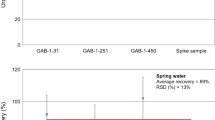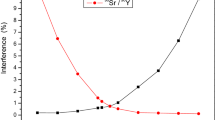Abstract
In our institute, different procedures have been developed to measure the radioactivity content of drinking water both in normal and in emergency situations, such as those arising from accidental and terrorist events. A single radiometric technique, namely low level liquid scintillation counting (LSC), has been used. In emergency situations a gross activity screening is carried out without any sample treatment by a single and quick liquid scintillation counting. Alpha and beta activities can be measured in more than one hundred samples per day with sensitivities of a few Bq/L. Higher sensitivity gross alpha and beta, uranium and radium measurements can be performed on water samples after specific sample treatments. The sequential method proposed is designed in such a way that the same water sample can be used in all the stages, with slight modifications. This sequential procedure was applied in a survey of the Lombardia district. At first tap waters of the 13 largest towns were examined, then a more detailed monitoring was carried out in the surroundings of Milano and Lodi towns. The high sensitivity method for the determination of uranium isotopes was used to check the presence of depleted uranium in Lake Garda. Reduced equipment requirements and relative readiness of radiochemical procedures make LSC an attractive technique which can also be applied by laboratories lacking specific radiochemistry facilities and experience.

Similar content being viewed by others
References
European Union (1998) Council Directive 98/83/EC of 3 November 1998 on the quality of water intended for human consumption. Off J Eur Commun L330, 5 December 1998
World Health Organization (1993) Guidelines for drinking water quality, 2nd edition, vol 1 (1993), vol 2 (1996). WHO, Geneva
Euratom (2001) Commission Recommendation of 20 December 2001 on the protection of the public against exposures to radon in drinking water supplies, 2001/928/Euratom
World Health Organization (1998) Guidelines for drinking water quality, 2nd edition, addendum to vol 2: health criteria and other supporting information. WHO, Geneva
Euratom (1989) Council Regulation n° 2218/89 of 18th June 1989 amending Regulation n° 3954/87 laying down maximum radioactive contamination of foodstuffs following a nuclear accident or any other case of radiological emergency. Off J Eur Commun L3211 22 July 1989
Knoll GF (1989) Radiation detection and measurements. Wiley, New York
Currie LLA (1968) Limits for qualitative detection and quantitative determination: application to radiochemistry. Anal Chem 40:586–593
International Standard Organization (1989) Water quality: determination of tritium activity concentration—liquid scintillation counting method. ISO 9698, Geneva
Forte M et al (2002) Natural radionuclide measurements in drinking water by liquid scintillation counting: methods and results. In: Proceedings of the 9th international symposium on environmental radiochemical analysis, Maidstone, Kent, 2002
Forte M et al (2002) Natural radionuclides monitoring in Lombardia drinking water by liquid scintillation technique. In: Proceedings of the symposium towards an harmonisation of radiation protection in Europe, Firenze, 2002
Bellinzona S (2002) Messa a punto di uno strumento per scintillazione liquida a basso fondo con possibilità di discriminazione α/β ed applicazioni a misure su matrici ambientali. PhD Thesis, Università degli Studi di Milano, Facoltà di Scienze Matematiche, Fisiche e Naturali, Milano
International Standard Organization (1992) Measurements of gross alpha activity in non saline water: thick source method. ISO 9696, Geneva
International Standard Organization (1992) Measurements of gross beta activity in non saline water: thick source method. ISO 9697, Geneva
IRC-CEC (2002) Report of intercomparison concerning the measurement of the gross alpha, gross beta, tritium activities and potassium concentration in a drinking water sample (August 2002)
International Standard Organization (1992) ISO guide to the expression of uncertainty in measurement. ISO, Geneva
UNEP (2003) Depleted uranium in Bosnia Herzegovina: post-conflict environmental assessment
AAVV (1992) In: Iovanovich M, Harmon RS (eds) Uranium-series disequilibrium: applications to earth, marine and environmental sciences. Clarendon, Oxford
Goldstein SJ et al (1997) Measurement and application of uranium isotopes for human and environmental monitoring. Health Phys 72(1):10–18
Bou-Rabee F (1995) Estimating the concentration of uranium in some environmental samples in Kuwait after 1991 Gulf War. Appl Radiat Isot 46(4):217–220
Sgorbati G, Forte M, Gianforma G, Rusconi R, Margini C (1998) Rilevazione delle concentrazioni di uranio-238 e radio-226 in acque destinate al consumo umano in Lombardia, A.S.L. Milano Città, 1998
Author information
Authors and Affiliations
Corresponding author
Rights and permissions
About this article
Cite this article
Rusconi, R., Azzellino, A., Bellinzona, S. et al. Assessment of drinking water radioactivity content by liquid scintillation counting: set up of high sensitivity and emergency procedures. Anal Bioanal Chem 379, 247–253 (2004). https://doi.org/10.1007/s00216-004-2580-7
Received:
Revised:
Accepted:
Published:
Issue Date:
DOI: https://doi.org/10.1007/s00216-004-2580-7




